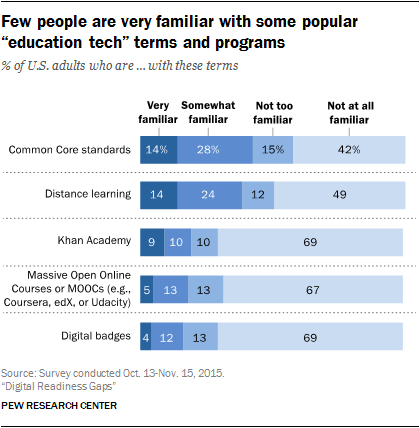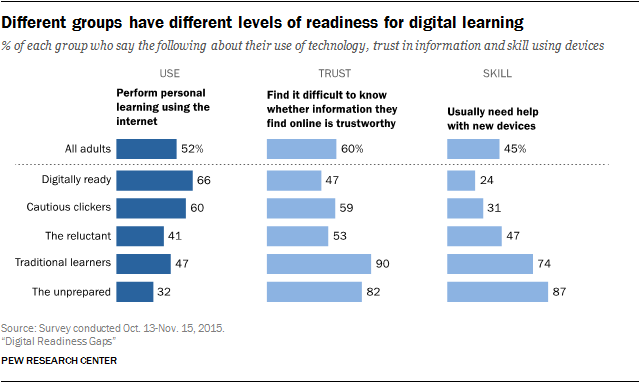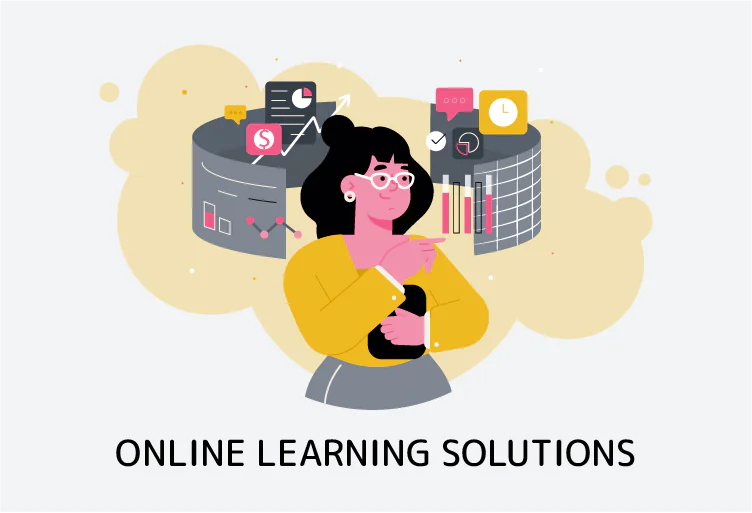Digital readiness is not so widely discussed in eLearning industry as compared to other buzzwords like augmented reality, virtual reality, bite-sized learning, mobile learning and whatever else — yet it plays one of the key roles in the growth of online education market as a whole. Why so? Let’s discuss it.
Actual data on the state of digital readiness in the US
We will begin with the definitions. Digital readiness is the degree of familiarity with modern digital technology, skills of its usage and the ability to determine the information trustworthiness. Thus said, digital readiness is not a single characteristic, it is rather a pattern of approaches to digital technology and ways of its usage.
The US population is slightly above 324 million people as of 2016. This is the most profitable market in the world for all kinds of businesses, eLearning industry in particular. However, enrollment figures on most online courses are no higher than tens of thousands usually, no matter the field of science. General student enrollment in online courses is around 6 million, with nearly 28% of the US students taking at least one course online, according to 13th annual Babson Survey Research Group report. This means that only few percents of the US population actually use the online learning, despite all the hype and the intentions to “re-invent the education”. This is directly connected to the state of digital readiness and below we will explain this in more details.
People don’t know about the possibilities new technologies provide, don’t have the skills to use them well or don’t trust the results.
Pew Research Center published a detailed report on the state of digital readiness in the US recently, we will provide few extracts and conclusions from it here. The survey have been conducted based on such ideas:
- Different people have different levels of proficiency in using modern technology (like smartphones and computers) and software (like eLearning solutions)
- This differentiation spreads even more throughout varying stratas of society (millennials are more computer-savvy, yet other generations can use online education too)
This means that despite all the tremendous accomplishments of modern technology, including the ones used in eLearning, people rarely benefit from these in the fullest. They simply don’t know about these possibilities, don’t have the skills to use them well or don’t trust the results. These parameters form the digital readiness state – how well does a person know about the possibilities the modern technology provides, are they prone to use these possibilities (find the needed information over the Internet, take the online courses) and do they trust the online industry (do they believe in validity of information received on the Internet; do they make effort to secure their personal data).
The surveyed people were asked personalized questions they could answer basing on their own experience, so that their overall level of technological background could be measured. For example, to evaluate the degree of their familiarity with digital concepts they had to say if they feel confident and keen with using computers and smartphones, do they sort out the usage of new electronic device on themselves – or do they require someone’s help, do they know of Common Core standards, Khan Academy, distance learning, MOOCs and digital badges that work as certificates of completion.
As we can clearly see, the majority of US adults surveyed are not aware of modern digital technology benefits and are not ready use its potential, including the online learning.
Fig. 1. Levels of familiarity with edtech terms and programs amongst the US adults
5 levels of readiness for digital learning
According to the statistical results of the abovementioned survey, 5 major groups of people can be compiled. These groups do not represent some certain social groups of US adults, they rather represent certain patterns in behavior with digital technology and certain levels of readiness to use it for elearning, distance learning and self-directed education:
- Digitally ready
- Cautious clickers
- The Reluctant
- Traditional learners
- The Unprepared
Fig. 2 Levels of digital readiness amongst the US adults
While the full explanation of these levels is available at the Pew Research Centre report, we will concentrate on the survey outcomes in regard to online learning.
It is easy to spot that huge numbers of difficulties in applying digital technology comes from the last 2 groups, mostly formed by elderly people who have no desire to invest their time into mastering digital technologies. The best rates of digital readiness are observed at millennials and cautious clickers groups, involving adults from 18 to middle-age with high-to-medium level of income.
The most important conclusion here, however, lies in observing the lower part of the chart, namely the Reluctant and Traditional learners. These groups of US adults perform rather well in online education, yet their trust is hard to earn and their skills with new devices and technologies are below average. However, it is a huge share of market that can be conquered if MOOC providers can overcome these 2 obstacles.
In our opinion,to achieve this goal eLearning industry should concentrate efforts in the following areas:
- Increasing general audience awareness regarding online courses and their usage
- Providing easy to comprehend bite-sized content
- Combining it into highly personalized online courses that require little to none technologically savvy skills to complete (or these skills can be effectively obtained during the course)
- Adapting UX for people who are not familiar with online learning solutions (and there should be an extensive and easily available help on each of the course aspects)
By providing such approach to eLearning adoption we can remove the obstacles that bar the road for huge audiences. This can substantially increase both the enrollment and completion rates, as well as finally revolutionizing the education and delivering it to the biggest audiences ever.
What is your opinion on the state of digital readiness and its impact on the state of online education? Please comment below, we are always glad to communicate!





